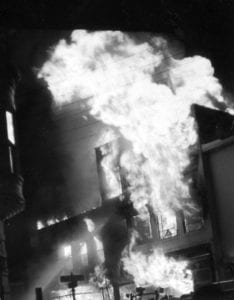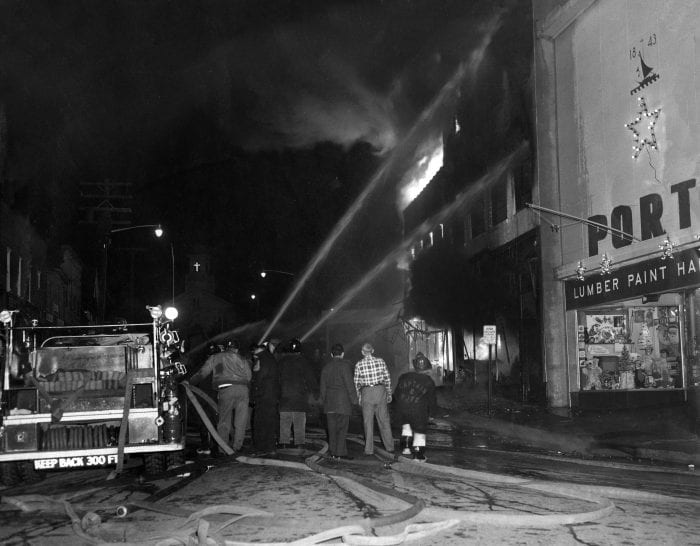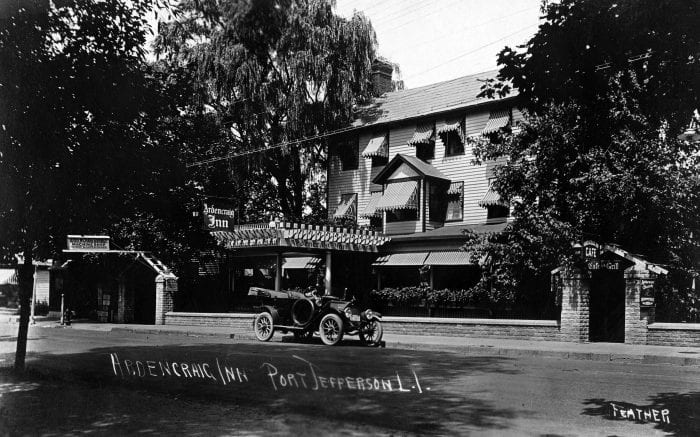By Kenneth Brady
A ferocious fire erupted at the O.B. Davis furniture store on Port Jefferson’s East Main Street at 6:20 p.m. on Monday, Dec. 26, 1960.
Erwin McMullen, whose East Main Street grocery was across from the furniture store, heard the sound of shattering glass hitting the sidewalk as windows in O.B. Davis were blown out by the intense heat.
Irving Lee, chief of the Port Jefferson Fire Department, and his wife Laura were driving on the village’s Main Street heading toward the Elk Restaurant when he saw the mass of flames. Not wasting a second in turning his car around, Lee quickly shifted into reverse, backed all the way to the firehouse on Maple Place and took command of the situation.
“The store was fully involved when units arrived at the scene,” recalled Mike Lee, who witnessed the blaze as a teenager and would later become chief of the PJFD. “Flames were shooting out of the upper floors of the building.”
The volunteer firemen spent hours battling the fire and protecting exposures at the Presbyterian Church, Port Hardware and nearby homes before bringing the roaring blaze under control.
Despite the best efforts of the PJFD, plus mutual aid from neighboring fire departments, the building was completely destroyed in the inferno.

The savage fire also claimed the life of Clifford Ivines, the store’s watchman and an over 50-year employee of O.B. Davis, whose body was later found in the building’s ruins.
“Not only did Port Jefferson lose a life and a landmark building in the devastating fire,” said longtime villager Barbara Schroeder who owns a prized desk bought at the O.B. Davis furniture store, “but also part of Port Jefferson’s history.”
O.B. Davis traces the firm’s origins back to 1858 when Elbert A. Raynor bought the late Ambrose T. King’s funeral parlor/furniture shop. The building was located approximately across from today’s Bridgeport-Port Jefferson ferry landing on East Broadway.
Raynor moved the firm in 1898 to East Main Street at Hotel Square. Upon Raynor’s death in 1914, Orlando B. Davis took over the business.
The company’s furniture and funeral divisions separated in 1935. The former continued its activities at Hotel Square while the latter began operations in a new home at 218 East Main Street.
In 1939, the existing furniture store was remodeled, and an addition was constructed to the west of the original quarters.
Built of steel frame and cinder block with stucco on the outside, the three-story addition provided elevator service, 15 model rooms and 17,000 square-feet of floor space. The front was faced with black porcelain and featured three show windows.
“At the time of the fire, one of the show windows at the furniture store included a beautiful canopied bed with white ruffles that I thought of buying for our newborn daughter Brenda,” remembered former Port Jefferson Mayor Sandra Swenk, “but the flames reduced everything to ruins.”
The twisted wreckage of what was once the largest retail furniture store in Suffolk County was hauled away after the fire. The Sil-Flo Building at 407 East Main Street, which houses the local United States Post Office, now occupies the site of the blaze.
Kenneth Brady has served as the Port Jefferson Village Historian and president of the Port Jefferson Conservancy, as well as on the boards of the Suffolk County Historical Society, Greater Port Jefferson Arts Council and Port Jefferson Historical Society. He is a longtime resident of Port Jefferson.






